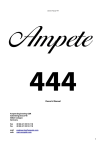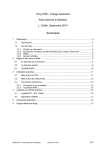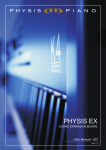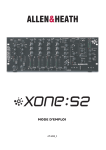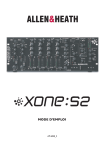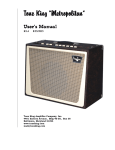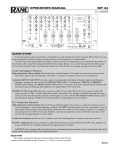Download RJM MasterMind User`s manual
Transcript
Ampete 444 Ampete Engineering GbR Gutenbergstrasse 48 50823 Cologne Germany 49 (0) 221 55 94 118 [email protected] ampete.com User's Manual 444 Ampete Engineering GbR, August 2014 Ampete is a registered trademark copyright 2014, all rights reserved User's Manual 444 We all.... ... produce electronic waste! It's just a matter of time! We here at Ampete Engineering are not only consumers, like you yourselves, but also engineers of electronic products that we want to place into a modern world. Here it looks at first glance that everything has been invented already. But demands are getting more refined and specific by the day and as in the economics, the sports- or even spiritual world, performance, utility and consistency depend on small changes and nuances in improvements. In other words we are supposed to get better every day. This is not a one way street, it's a huge responsibility in the other hands! For us it means more than wanting a slice of the pie. It means to review every single product we design for its added values, to anticipate the circumstance you put it into in order to ‚simply' be able to maintain it everywhere it has been sold to. Today our whole life is determined by electronics, at home, on the road, at work or vacation, in supermarkets, concert arenas or even in natural resorts. Today in general electronics aren`t built any longer to last! They`re cheap. For people from the 70ies like us it is a turning point. We grew up in a world where an electronic device is nothing short of a masterpiece. Today 90% of electronic applications are manufactured by using robots or exploitation in countries where `global players` celebrate the abolition of workers protection and minimum salaries. But it doesn’t end there. After an expected life cycle, more or less short, the cheap electronic waste is gonna be ‚disposed‘ of. Dispose might suggest that components like housing, metal and synthetics will be recycled to find their way back into a product. But of course often this is not how it is done! If you ever heard of 'toxic city' (and I don't mean the fantastic album of a great band) you probably know what we speaking of. It might surprise you to read this in a manual for an electronic device. We want to make sure that you understand that by purchasing an Ampete Engineering Product you will get a device in which we put all our passion, belief and knowledge and that you get a product in the tradition of many great people before us, for whom electronics were and still are wonderful masterpieces. But you also purchased a little piece of responsibility. Maintain your Ampete Engineering Product – we will be here to support you, we built this to survive… possibly even us. In case you should be faced with any issue on any day at any place somewhere in the world, we are here as you would expect us to be. This is not a promise, it is our view of life. Thanks for letting us be a part in enabling your musical world. User's Manual 444 Table of Contents – – – – – – – – – – Foreword Introduction Features Front panel Back panel hooking up amplfiers and cabinets to the 444 controlling the 444 via front panel switches controlling the 444 via midi control change midi changes Troubleshooting User's Manual 444 Introduction The 444 is designed to combine guitar amplifiers, guitar cabinets and guitar effects! There have been Audio Loopers before, but there hasn't been the possibility to route one out of four amplifiers into one or two out of four cabinets. Wait... one out of two, two out of what?? … furthermore you are not any longer in need of several delay, reverb, modulation pedals or rack units as there hasn't been the oppurtunity before to route every single FX loop of your amplifiers into one common FX loop for driving one common FX unit or one common FX rig. … one common what??? … nor there has been the option to run a wet/dry/wet system from one system of several guitar amplifiers without using line mixers and audio transformers and... … transformers???? Okok, don't get nervous, it sounds complicate, but indeed it's very simple and the 444 truly simplifies your guitar rig in a way you have never seen it before, simply by using our old and beloved midi pedal. We will guide you through a guitar rig GAS jungle in this manual. Features – – – – – – – – – – – 4 amplifiers selectable 4 speaker cabs selectable, up to 2 at a time FX-Loops from any of the connected amplifiers assignable to one common FX Loop Line out for driving external power amplifiers when running W/D/W systems buffered and unbuffered inputs feed thru jacks for easy wiring in the rack amplifier and cabinet selection without loss in sound, dynamics or noise no switching noises no switching latency protection circuits to prevent amplifiers from damage midi controllable via program change or control change User's Manual 444 Front Panel 1. FEED THRU: Jack for an ungrounded direct signal connection from/to the backpanel FEED THRU. Use it for connecting tuners, wireless systems or any connection you need from back to front without using long cable connections. 2. BUFFER IN: Front Panel instrument input, which routes the instrument signal to your connected amplifier inputs via a high to low impedance buffer, for keeping signal clean and noiseless without coloring it. 3. AMPS 1-4: Select one of four possible connected amplifiers by pushing the corresponding illuminated switch. The other 3 amplifiers are connected to an internal load to prevent them from any damage. Input signal is only routed to the selected amplifier. 4. CABS 1-4: Select up to two cabinets at the same time by pushing the corresponding illuminated switch. 5. FX LOOP ON/OFF: Switches the FX Loop Send/Return jacks of the currently chosen amplifier to the FX Loop In and FX Out jacks to share one FX unit or FX rig with all of the 4 connected amplifiers. That way spillover effects from reverb or delay effects are possible between the different amplifiers. Please be aware to set the send and return levels of the connected amplifiers equally to avoid changes in volume. 6. MIDI CHANNEL/CC MODE: Displays and selects the Midi Channel when pressed short. Toggles the Control Change mode when pressed long 7. SAVE: Saves the current state of the 444 to the previously selected Program Change preset. 8. Display: gives informations about the selected Program Change preset, Midi Channel, or Control Change mode. 9. Power On/Off: I bet you know what this is for... User's Manual 444 Rear Panel 1. PHANTOM POWER PEDAL Jack: Connect a DC power supply to provide phantom power for your MIDI pedal. By default the DC jack is connected to 3 and 4. 2. AC JACK / AC VOLTAGE SELCTOR: When changing AC voltage for using the 444 in a different country. Make sure fuse values are correct. 3. GROUND LIFT: Controls wether the 444s audio ground is connected to earth conductor or not. The chassis is grounded when the switch is in the 'Out' position. We recommend this position when using the 444 as the input device for your guitar. In case you are using other audio loopers in front of the 444, you might notice hum noise, which is most often caused by ground loops between two devices. Switching the ground lift to the 'In' position will solve the issue. 4. MIDI THRU: If you have several MIDI devices in your setup, connect the Midi Thru with the midi in of the following device. 5. MIDI IN: Connect a MIDI pedal or any other MIDI device, to control the 444 via Program Change or Control Change messages. If your MIDI device can be powered via the MIDI cable, connect the correct DC power supply to the PHANTOM POWER PEDAL jack. Make sure supply voltage and pin assignment is correct (see ___) 6. LINE OUT: Outputs the SPEAKER Outs or FX LOOP Send signal of the currently selected amp at line level. It can be internally jumpered to be a speakers or an FX send line out. We recommend the speaker setting, which also is set by default. Note that when feeding the LINE OUT from the FX Send Bus, it's only active when the chosen amps FX loop is connected and engaged! 7. AMP1 SEND: Connect the FX Loop Send/preamp out/line out of Amplifier 1 to the AMP 1 SEND jack of the 444. Please be aware that this is not an independent loop but the corresponding FX loop of the amplifier you drive with the AMP INPUT 1 and AMP OUTPUT 1 jacks of the 444! 8. AMP1 RETURN: Connect the FX Loop Return/power amp in/line in of Amplifier 1 to the AMP 1 RETURN of the 444. Like before mentioned, this is not an independent loop but the corresponding FX loop of the amplifier you drive with the AMP INPUT 1 and AMP OUTPUT 1 jacks of the 444! 9. AMP2/3/4 SEND and AMP2/3/4 Return: Proceed like described under point 7 and 8. 10. FX IN: Connect the FX IN jack of the 444 to the input of your effect, wether it is a single unit like a delay pedal, a chain of pedals or rack units or another audio looper. This is exactly like you would connect it to your amp's FX Loop Send. When switching between amps on the 444, it automatically switches your effects to the currently selected amp. 11. FX OUT: Connect the FX OUT jack of the 444 to the Output of your effect, wether it is a single unit like a delay pedal, a chain of pedals or rack units or another audio looper. This is exactly like you would connect it to your amp's FX Loop Return. When switching between amps on the 444, it automatically switches your effects to the currently selected amp. User's Manual 444 12. FX LOOP GND LIFT: Normally . The FX LOOP GND LIFT lets you suppress possible pops when switching between 2 amps with using spillover effects like long delays or reverbs. This is most often caused by a static voltage growing to a non grounded electronic signal path or switching between from one audio ground to another. In almost any case that switch will solve the issue 13. BUFFER IN: BUFFER IN to drive the AMP INPUTS of the 444. Same as BUFFER IN at the front side, but with priority to the front panels jack. Disconnected when front panels BUFFER IN is in use. 14. FEED THRU: direct ungrounded signal connection to the front panel FEED THRU jack only to simplify the rack wiring. 15. SPEAKER CABINETS 1-4: Connect your speaker cabinets here. No matter which cabinets you choose, from 1x12“ to 4x12“ with every impedance everything is possible, but consider not to exceed the power handling of the speaker cabinet to avoid any damage to the speakers and/or the amplifier. Use speaker cables only! 16. AMP OUTPUTS 1: Connect the loudspeaker/cabinet/amp output outputs of amplifier 1 here. This is NOT an independent output but it corresponds to the number of the AMP INPUT 1 and the AMP1 SEND and RETURN jacks of the 444. Use speaker cables only! 17. UNBUFFERED IN: Input between the BUFFER IN and AMP INPUTS. This input bypasses the buffer, when it's used, the BUFFER IN jacks are disconnected. We recommend this input when using preceded buffer units or preamps. 18. AMP INPUTS 1-4: Connect the instrument inputs of your amps here. This is the most sensitive connection setting up the 444, make sure to use high quality instrument cables. User's Manual 444 A Typical Setup AMP1 FX RETURN AMP1 INSTR. IN AMP1 FX SEND AMP1 SPEAKER OUT AMP 1 AMP2 FX RETURN AMP2 FX SEND AMP1-4 RETUR N FX OUT OUTPU T AMP 2 AMP2 INSTR. IN AMP3 INSTR. IN AMP3 FX SEND AMP3 SPEAKER OUT AMP4 FX RETURN AMP4 INSTR. IN AMP4 FX SEND AMP4 SPEAKER OUT AMP 4 AMP1-4 SEND 444 FX OUT CAB 2 AMP2 SPEAKER OUT AMP3 FX RETURN AMP 3 CAB 1 CAB 3 CAB 4 AMP1-4 OUTPUT S LINE OUT AMP1-4 INPUTS SPEAKER CABINETS 1-4 MIDI IN INPUT EFFECTS ADDITIONAL POWER AMPS MIDI CONTROLLER User's Manual 444 Controlling the 444 via the front panel Selecting Amplifiers and Cabinets / Switching rules & protection At this point you hooked up your amplifiers and cabinets to the 444. Let's start switching! You should establish a certain operating process when operating the 444. Either in the operating way via the front panel switches or when programming midi presets, a cabinet has to be chosen by pressing the corresponding front panel CABS switch. It is NOT possible to select an AMPS switch before. Again, a CABS button can only be selected with a speaker cabinet hooked up to the corresponding SPEAKER CABINETS jack. Thereby the 444 not only controls if a plug is connected to the SPEAKER CABINETS jack, but also the attached load for its impedance. Hereby a low impedance is interpreted as a speaker cabinet, a high impedance could be a non connected cable, a defective speaker cable or even a speaker in form of a ruptured speaker coil etc. In that case the 444 would refuse the selection and state an n.c. in the display for 'no connection'. This way the 444 prevents your amplifier from damage because of running without a load. The display will state an error status (Er). Again the main facts – – Select CABS button first. Two cabinets can be selected. If two cabinets are selected, one of the chosen has to be switched off first, before the 444 lets you select another. Select AMPS button next. One amp at a time can be selected, which means by selecting another AMPS button the 444 disables the previously chosen amplifier. – FX Loops The FX loop option allows to run one single effect unit to any of the FX loops of your connected amplifiers. That way you are not any longer in need of several effect units for several amplifiers. Here it surely does not matter if you run single or a chain of effect units for instance connected to a further audio looper unit. FX LOOP ON/OFF button can not be selected without a cabinet and an amplifier selected. When engaged, the FXLOOP ON/OFF switch will light up to show its active status. The FX IN / FX OUT jacks are now connected to the FX Loop Send/Return of the selected amplifier. When switching between amplifiers, the 444 switches the FX IN / FX OUT jacks to the selected amp's FX Loop at the same time. Controling via MIDI Checking and setting the MIDI Channel By pressing the MIDI CHANNEL button (5), the display (7) will show the currently active midi channel. This is indicated by an additional decimal point at the lower right corner of the display for only a few seconds before the display switches back to the midi program number. To set the MIDI channel, consecutively press MIDI CHANNEL for a short period of time. The displayed number counts up to '16', and starts again at '0'. Stop pressing MIDI CHANNEL if the desired MIDI Channel number is reached. '0' stands for 'all channels' or 'omni mode'. As soon as the display switches back to the previous state, the MIDI channel is saved to the non-volatile memory of the 444. User's Manual 444 MIDI Program Change The 444 offers the possibility to save up to 99 presets of different amplifier / cabinets combinations. You can switch between presets by sending MIDI Program Change messages from your MIDI foot controler, or any other MIDI device connected to the 444 „MIDI IN“ connector. To save a preset, send a MIDI Program Change message of the desired preset number. The switcher status saved with the preset number is called, and the preset number is shown in the front panel display (7). Note that the 444 starts counting the presets at „1“, even thought the MIDI standard internally starts at „0“. The reason we did this is because almost any MIDI foot controler start counting the foot switches at „1“ as well. If the preset is now changed by the front panel controls, the SAVE knob starts flashing. Press SAVE to save the current status to the preset. To protect your amps, a preset can not be activated if at least one of the cabinets saved with the preset is not connected to the 444. In this case the display shows the status (n.c.). MIDI Control Change All front panel controls can additionally be remote controlled by MIDI Control Change messages. In contrast to calling complete presets via MIDI Program Changes, every Control Change message switches only one function at a time. That is why you might have heard people calling this method „Direct Access“. See „Control Change messages table“ for a detailed description of the 444 Control Change messages. MIDI Control Change modes Even though Control Change messages only access one function at a time, some people prefer programing presets of several Control Change messages inside their MIDI controler, instead of sending Program Change messages to access a preset stored in the 444. MIDI controler in a higher price range like the RJM Mastermind GT offer the possibility to send the Control Change presets in an „intelligent“ way, meaning it also sends CC messages to switch the currently used amp or cabinet off before switching on another one. This is important as the 444 has certain rules and orders for the switching process to protect your amps from any damage. (see „switching rules & protection). For this scenario you should use the 444 Control Change mode „0“. If you are using a MIDI controler which has a more simple software structure - and for this does not „know“ which amp or cabinet is currently in use - or if the number if CC messages in a preset is limited, it might work for you to use the 444 Control Change mode „1“. In this mode the 444 only processes Control Change messages having the value 127 („switch on“), after switching of every amp or cabinets which is currently in use. If you are not sure which CC Mode is best for you, always start out with CC Mode 0, which is the 444 factory preset. This is the correct mode for most cases, especially if you are sending single CC messages, and not presets of several CC messages. When programing presets of CC messages to your MIDI controler, always keep in mind that the 444 works after certain rules for the switching process mentioned before. I.e. if you prgram a preset that sends commands to switch on two amps at a time, the 444 will only show an error status (Er) in the display. User's Manual 444 Setting the Control Change mode To set the Control Change mode on the 444, press MIDI CHANNEL (5) for a long period of time until the display (7) shows „0“ or „1“ with an additional decimal point in the lower right corner. Note that in contrast to setting the MIDI Channel this action directly toggles the CC Mode, there is no way to check the current setting first. Control Change messages table CC Controler Number Function Value 80 AMP 1 0=off, 127=on 81 AMP 2 0=off, 127=on 82 AMP 3 0=off, 127=on 83 AMP 4 0=off, 127=on 88 FX LOOP 0=off, 127=on 90 SAVE 127=save 104 CAB 1 0=off, 127=on 105 CAB 2 0=off, 127=on 106 CAB 3 0=off, 127=on 107 CAB 4 0=off, 127=on User's Manual 444 Troubleshooting Problem: No signal when an amplifier (AMP1-4) is chosen: Make sure you conneted the amps input and speaker output correctly. For instance connect AMP1 INPUT and AMP1 OUTPUT to the same connected amplifier. Problem: No signal when switching FX loop. Make sure the FX Loop of the chosen amplifier is connected correctly to the 444s matching FX Loop. For example, if AMP1 is chosen, the AMP1 FX SEND and RETURN have to be connected to the same amplifier, which is connected to AMP1 INPUT and AMP1 OUTPUT of the 444! Problem: No amp can be selected. Check if a cabinet is selected. Problem: No cabinet can be selected. Please check if the chosen cable and (!) cabinet is connected properly. Problem: drastic volume increase or decrease when switching between amplifiers with FX loop option Problem: clicking noise when switching between amplifiers with FX loop option using long delay or reverb times. A word on impedances When it comes to impedances, there have been written a lot of words and there have been told many opinions, myths and beliefs. And as it is always in our world, all of them are in between the truth and the untruth. Some more, some less. Don't expect mine to be the only truth, it's mine but i want to give you some arguments on hand. Trafos und Lautsprecher sind Spulen, also freuqenzabhängig. Röhren sind nicht frequenzabhängig, sondern die sie umgebende Schaltung ist es. Die angegebene Impedanz ist eine Definition bei 1kHz. User's Manual 444 Ampete Engineering GbR, 2014 Ampete is a registered trademark copyright 2014, all rights reserved User's Manual 444














